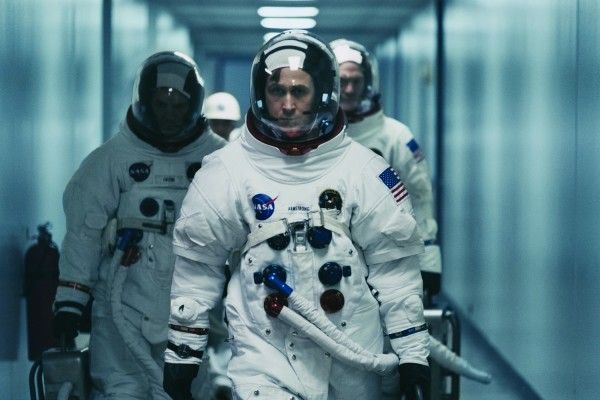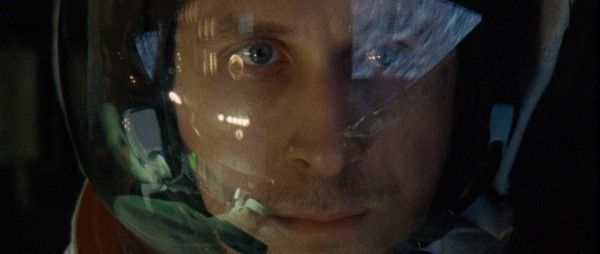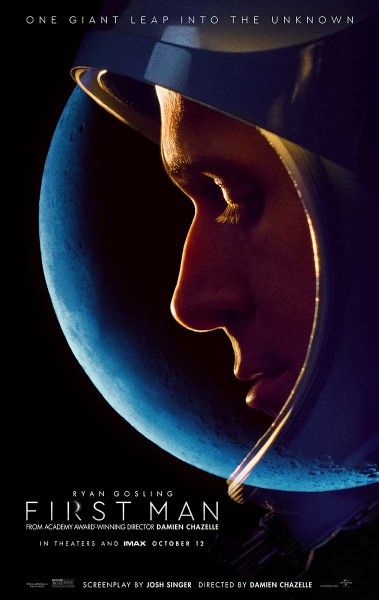[This is a repost of my review from the 2018 Toronto International Film Festival. First Man opens today.]
Watching Damien Chazelle’s First Man, I was struck by how relatively easy space travel looks in other movies documenting the history of NASA’s famous missions. That’s not to say that the people don’t work hard or that there aren’t dramatic stakes, but rather there’s a sense of control. You see all these brilliant minds at work in nice, clean rooms filled with computers, screens, and equations, and you know that everything is going to work out. Chazelle brings a sense of danger to the space program rarely seen before in major Hollywood films. The attention to detail is astounding as we see not some pristine science project, but an endeavor held together by hope and will. We see all this through the eyes of Neil Armstrong (Ryan Gosling), and while we get a terrific sense of his mission, we’re still left in the dark about the man.
Starting in 1961, the film chronicles Armstrong’s journey through the space program, starting with his work as an engineer and test pilot in the Mojave Desert to joining the NASA program to get men to the moon. We’re told that the reason the moon is the goal is because the Soviets are dominating in the space race and that planning a lunar landing basically forces both the Americans and the Soviets to start from scratch because the endeavor is so complex. The plan is to start with the Gemini missions that will pave the way for Rend Dock (docking in space), which is essential for making the trip to the moon. As Armstrong works his way through various missions, his resolve is tested both by the haunting loss of young daughter, who died of cancer, and from the loss of his fellow astronauts.
Chazelle obviously had a clear vision for the look of the movie, which was to put viewers inside the cockpits of these vehicles and get a feel for what it was like for Armstrong and his colleagues to risk their lives in buckets of bolts to get America to the moon before the USSR. The director succeeds wildly, and puts to shame other space movies that hinted at the danger. Here, you feel like you need to strap yourself to your chair, especially during the Gemini 8 mission. Through First Man, we can feel everything on the verge of falling apart, every screw straining against the hull, and the claustrophobia of only having a small window to look through. There’s no reprieve in the missions of First Man, only the danger of everything about to implode.
Putting viewers into Armstrong’s experience is a monumental accomplishment because we know how his story goes. We shouldn’t feel any danger or risk, but through brilliant cinematography, editing, and sound mixing, the experience becomes visceral and immediate. Every detail, from the corrosion on a screw to the condensation on a window feels far more real, and you can feel the tension and the risk involved. First Man isn’t so much about showing accomplishments as much as what was risked to achieve those accomplishments in the first place.
The problem comes with the protagonist. On the one hand, you could argue that First Man isn’t really a biopic at all and that Armstrong is simply the way for Chazelle and screenwriter Josh Singer to tell a story about the space program. But if that were their intention, then an ensemble approach would have worked far better by showing the lives and struggles of a group of people working together towards a common purpose. Sticking with Armstrong provides a nice through line, but it’s also a character in search of a compelling personality.
To be fair, if Armstrong were somehow deeply “damaged” or ruthlessly complex, they wouldn’t let him lead the mission to the moon. His steadiness is one of his positive attributes so Chazelle and Gosling try to turn this to their advantage by portraying Armstrong as somewhat aloof, quiet, and a little robotic. For Gosling, it’s yet another great performance as he has to convey Armstrong’s emotional weight without the benefit of emotional outbursts or anything else to let us inside the mind of a reserved individual.
But because Armstrong is so remote, the character never really feels alive. The screenplay tries to make Armstrong’s story about the constant presence of death, first from his daughter and then from his colleagues, but we rarely see Armstrong grieve or react in a way that makes him relatable. He keeps his emotions bottled up and always remains professional. Those qualities made him a great astronaut, but it creates a barrier between the protagonist and the audience. He doesn’t even seem to have much of a connection with his wife Janet (Claire Foy), whose principal job is to be scared, worried, and annoyed.
First Man is both a movie about NASA’s mission to the moon and a Neil Armstrong biopic. When it’s about the mission, First Man is untouchable with the kind of vision, verve, and brilliance we’ve come to expect from Chazelle. The film sets a new bar for other movies about the history of space travel, and I say that as someone who adores Apollo 13. However, when the focus is on Armstrong, everything feels far safer, and at odds with the exhilarating story that surrounds the famed astronaut.
Rating: B





